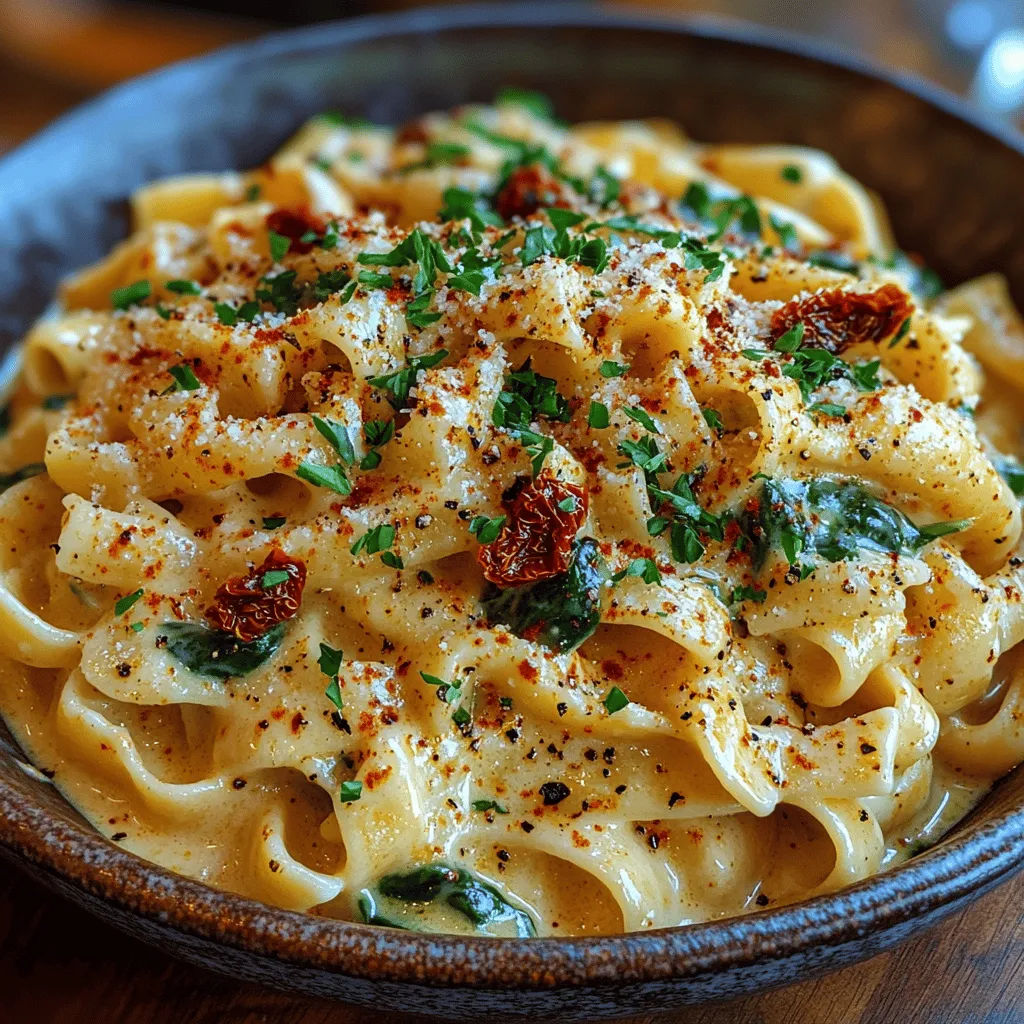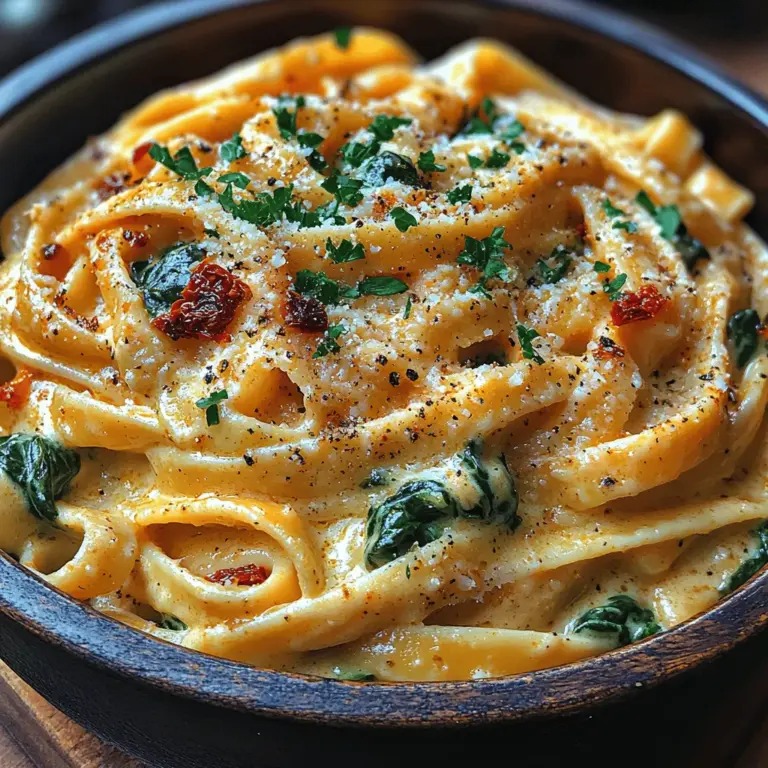Introduction
Creamy Spinach Pasta Alfredo is a delightful and comforting dish that perfectly embodies the essence of indulgent Italian cuisine. The lusciousness of the Alfredo sauce combined with the vibrant freshness of spinach creates a harmonious balance that appeals to both the palate and the eye. This recipe is not just a meal; it’s an experience that brings warmth and satisfaction, making it a favorite among pasta enthusiasts and comfort food lovers alike.
The allure of creamy pasta dishes lies in their ability to provide a sense of comfort and nostalgia, often evoking memories of family dinners and cozy nights in. The rich, velvety texture of Alfredo sauce coats the pasta, enveloping each bite in creamy goodness. It’s no wonder that pasta Alfredo has earned its place as a staple in many kitchens, particularly during chilly evenings when a hearty meal is most welcome.
Moreover, this dish incorporates spinach, a leafy green that not only adds a pop of color but also comes with a host of health benefits. Spinach is packed with essential vitamins and minerals, including vitamin A, vitamin C, calcium, and iron. When paired with pasta, it transforms this dish from a simple indulgence into a more nutritious option, allowing you to enjoy the creamy richness while still being mindful of your health.
Understanding the Ingredients
To create the perfect Creamy Spinach Pasta Alfredo, it’s essential to understand the key ingredients that contribute to the dish’s flavor and texture. Each component plays a vital role, ensuring that the final product is both delicious and satisfying.
Fresh Spinach: Nutritional Benefits and Flavor Profile
Fresh spinach is the star of this recipe, providing not only a vibrant green hue but also a myriad of health benefits. This nutrient-dense vegetable is an excellent source of antioxidants, which play a crucial role in protecting the body against free radicals. Additionally, spinach is low in calories, making it an ideal addition to any dish aiming for a balance of indulgence and health.
Flavor-wise, fresh spinach has a mild, slightly earthy taste that complements the richness of the Alfredo sauce beautifully. When cooked, it wilts down to a tender texture, blending seamlessly with the creamy pasta, while still retaining its nutritional integrity.
Fettuccine Pasta: Why It’s the Best Choice for Alfredo
When it comes to pasta choices for Alfredo, fettuccine is the clear winner. This flat, ribbon-like pasta is particularly adept at holding onto creamy sauces, allowing each strand to be generously coated in the rich Alfredo mixture. The wide surface area of fettuccine ensures that every bite is filled with flavor, making it a classic pairing for this dish.
Cooking fettuccine to the perfect al dente texture is key. This method not only enhances the eating experience but also ensures that the pasta holds up well when combined with the sauce, preventing it from becoming mushy or overly soft.
Heavy Cream and Parmesan Cheese: The Foundation of a Creamy Sauce
The heart of any Alfredo sauce lies in its creamy base, typically made from heavy cream and Parmesan cheese. Heavy cream contributes to the sauce’s luxurious texture, providing that sought-after creaminess that Alfredo is famous for. It also serves as the perfect canvas for flavor absorption, allowing the garlic and spinach to shine through.
Parmesan cheese, on the other hand, adds a salty, nutty flavor that elevates the richness of the cream. This aged cheese melts beautifully into the sauce, creating a velvety finish that clings to the pasta. For the best results, opt for freshly grated Parmesan, as it melts more efficiently and adds a fresher taste compared to pre-packaged grated options.
Optional Ingredients and Their Enhancements
While the basic recipe for Creamy Spinach Pasta Alfredo is delicious on its own, there are several optional ingredients that can enhance the dish even further. Consider adding sun-dried tomatoes for a punch of tangy flavor. Their concentrated sweetness contrasts beautifully with the creaminess of the sauce, creating a well-rounded dish that excites the palate.
Fresh parsley is another excellent addition, not only for its vibrant color but also for its fresh, herby flavor. Sprinkling chopped parsley over the finished dish adds an aesthetic touch while providing a burst of freshness that complements the richness of the Alfredo sauce.
Preparing the Creamy Spinach Pasta Alfredo
Now that we understand the ingredients that make up this delightful dish, let’s dive into the preparation process. Cooking Creamy Spinach Pasta Alfredo is straightforward, allowing even novice cooks to create a restaurant-quality meal in their own kitchen.
Detailed Steps for Cooking the Pasta
Begin by bringing a large pot of salted water to a rolling boil. The salt is crucial as it adds flavor to the pasta as it cooks. Once the water is boiling, add the fettuccine and stir gently to prevent sticking. Cook the pasta according to the package instructions until it reaches an al dente texture, typically around 8 to 10 minutes. Al dente pasta should be firm to the bite, allowing it to hold up when mixed with the creamy sauce.
Once the pasta is cooked, reserve about a cup of the pasta water before draining the rest. This starchy water can be a valuable asset in adjusting the sauce’s consistency later on, ensuring that it clings perfectly to the fettuccine.
Importance of Al Dente Texture and How to Achieve It
Achieving the perfect al dente texture is a crucial step in preparing your pasta. To do this, start checking the pasta a couple of minutes before the recommended cooking time. Take a piece out and taste it; it should be tender yet still have a slight bite. If it’s too soft, it will lose its shape when mixed with the sauce.
Removing the pasta from heat while it still has a bit of firmness will allow it to continue cooking slightly, especially once combined with the hot Alfredo sauce.
Sautéing Garlic and Spinach
While the pasta is cooking, it’s time to prepare the garlic and spinach. In a large skillet, heat a tablespoon of olive oil over medium heat. Add minced garlic and sauté for about 30 seconds, just until fragrant. Be cautious not to burn the garlic, as it can turn bitter and ruin the dish.
Once the garlic is aromatic, add the fresh spinach to the skillet. Stir frequently as the spinach wilts down, which should take about 2 to 3 minutes. This step not only adds flavor but also ensures that the spinach is tender and ready to blend into the creamy sauce.
Techniques for Maximizing Flavor During Sautéing
To maximize flavor during the sautéing process, consider adding a pinch of salt and a dash of black pepper to the garlic and spinach. This not only enhances the taste but also helps to draw out moisture from the spinach, intensifying its flavor. Cooking the garlic just until it’s golden and fragrant will create a flavor base that permeates the entire dish.
Creating the Alfredo Sauce
With the pasta cooked and the garlic and spinach sautéed, it’s time to create the creamy Alfredo sauce. In the same skillet that you used for the garlic and spinach (this adds depth of flavor), pour in the heavy cream over medium heat. Allow the cream to warm, but do not bring it to a boil.
Once warmed, gradually add in the freshly grated Parmesan cheese, stirring continuously to help it melt smoothly into the cream. The goal is to create a rich and creamy sauce without any lumps. If the sauce appears too thick, you can gradually add a little of the reserved pasta water until you reach your desired consistency.
Step-by-Step Process of Integrating Cream and Cheese
1. Heat the Cream: Pour the heavy cream into the skillet with the garlic and spinach, stirring gently to combine.
2. Add the Cheese: Slowly sprinkle the grated Parmesan cheese into the warm cream, keeping the heat on medium. Stir continuously until the cheese has completely melted and the sauce is creamy.
3. Adjust Consistency: If the sauce is too thick, add a bit of the reserved pasta water, one tablespoon at a time, mixing well after each addition until you achieve a silky consistency.
4. Combine with Pasta: Finally, add the drained fettuccine directly into the skillet, tossing gently to coat the pasta evenly with the creamy Alfredo sauce. Ensure that the spinach and garlic are well-distributed throughout the pasta.
By following these steps, you’ll create a Creamy Spinach Pasta Alfredo that is not only visually appealing but also bursting with flavor. The combination of tender fettuccine enveloped in a creamy sauce, complemented by the freshness of spinach, is sure to impress anyone at your dinner table.

Tips for Achieving the Perfect Sauce Consistency
Achieving the perfect sauce consistency is crucial for a delightful Creamy Spinach Pasta Alfredo. Here are some essential tips to ensure your Alfredo sauce is creamy and velvety:
1. Start with the Right Base: Begin with a combination of butter and heavy cream, as this will create the rich base needed for a traditional Alfredo sauce. Avoid using low-fat options for the cream, as they may not thicken properly and can result in a watery sauce.
2. Cook Over Low Heat: Once you combine your butter and cream, keep the heat low to avoid scorching the milk. This gentle heat allows the sauce to thicken gradually without curdling.
3. Incorporate Cheese Gradually: When adding Parmesan cheese, do so gradually and stir continuously. This technique helps the cheese melt evenly, preventing clumps and ensuring a smooth sauce.
4. Use a Thickening Agent if Needed: If your sauce is still too thin after incorporating the cheese, consider adding a bit of cornstarch mixed with cold water. Stir this mixture into your sauce and allow it to simmer for a few minutes until it thickens to your desired consistency.
5. Adjust with Pasta Water: The starchy pasta water can be a lifesaver when adjusting the sauce’s thickness. If the sauce becomes too thick, add a splash of the reserved pasta water until you reach your desired consistency.
Combining the Pasta with the Sauce
Once your sauce is ready, it’s time to combine it with your cooked pasta. Follow these steps for a seamless mix:
1. Cook the Pasta Al Dente: Be sure to cook your pasta al dente according to package instructions. This ensures that the pasta retains a slight firmness and doesn’t become mushy when mixed with the sauce.
2. Reserve Pasta Water: Before draining your pasta, reserve about a cup of the cooking water. This starchy water will help bind the sauce and pasta together, enhancing the texture.
3. Add Pasta to Sauce: In a large skillet or saucepan, add your drained pasta directly into the creamy sauce. Use tongs or a pasta fork to gently toss the pasta with the sauce, ensuring every strand is coated.
4. Incorporate Spinach: If you haven’t added the spinach yet, now is the time. Stir in the cooked spinach until it is evenly distributed throughout the pasta and warmed through.
5. Enhance Texture: If the pasta appears too dry or the sauce too thick, gradually add reserved pasta water, a few tablespoons at a time, to achieve the desired creaminess and consistency.
Techniques for Ensuring Even Distribution of Sauce
Even distribution of sauce is essential for a well-balanced dish. Here are a few techniques to ensure your Creamy Spinach Pasta Alfredo has a uniform coating:
1. Toss Instead of Stirring: Use a tossing motion rather than stirring vigorously. This technique helps to coat the pasta without breaking it or causing it to clump together.
2. Use a Large Enough Pan: Ensure you’re using a sufficiently large skillet or pot to allow enough space for the pasta and sauce to mix freely. Crowding the pan can lead to uneven distribution.
3. Mix in Batches: If you’re making a large batch, consider mixing the pasta and sauce in smaller portions. This method allows for better control and ensures that every piece of pasta is well-coated.
4. Finish with Heat: After combining, allow the pasta to sit in the skillet over low heat for a couple of minutes. This will help the pasta absorb some of the sauce, enhancing flavor and cohesion.
Nutritional Benefits of Spinach
Spinach is not only a delicious addition to Creamy Spinach Pasta Alfredo but also packs a nutritional punch. Here’s a closer look at its health benefits:
Highlighting the Health Aspects of Spinach
Spinach is a leafy green vegetable that is low in calories but high in nutrients. This superfood is an excellent choice for those looking to boost their vegetable intake without adding excessive calories.
Vitamins and Minerals Found in Spinach
Spinach is rich in several essential vitamins and minerals, including:
– Vitamin K: Important for bone health and blood clotting.
– Vitamin A: Supports eye health and immune function.
– Vitamin C: An antioxidant that helps protect cells and supports skin health.
– Folate: Vital for DNA synthesis and repair, making it especially important for pregnant women.
– Iron: Essential for oxygen transport in the blood, helping to prevent anemia.
Discussing the Role of Spinach in a Balanced Diet
Incorporating spinach into your diet can help enhance overall health. Its fiber content aids digestion, while its antioxidants combat oxidative stress, making it a valuable addition to any meal.
How Adding Greens to Pasta Dishes Can Increase Nutritional Intake
By adding spinach to pasta dishes, you can easily boost their nutritional profile. Greens like spinach provide vitamins, minerals, and fiber, making your creamy pasta not only indulgent but also a healthier option. It’s an excellent way to sneak in extra nutrients, especially for those who may not consume enough vegetables.
Variations and Customizations
The beauty of Creamy Spinach Pasta Alfredo lies in its versatility. Here are some ideas for customizing the dish to suit your taste preferences:
Exploring Different Options for Enhancing the Dish
1. Add Protein: For a heartier meal, consider adding cooked chicken, shrimp, or even diced sausage. These proteins can enhance the dish’s flavor and make it more filling.
2. Vegetarian and Vegan Alternatives: To keep the dish vegetarian, you could use plant-based cream and cheese alternatives. For a vegan version, substitute heavy cream with coconut cream or cashew cream and use nutritional yeast for a cheesy flavor.
3. Creative Seasonings and Spices: Elevate the taste of your Alfredo sauce by adding spices such as garlic powder, onion powder, or freshly cracked black pepper. A pinch of nutmeg can also bring out the creaminess in the sauce.
4. Incorporate Other Vegetables: Mix in other vegetables like sun-dried tomatoes, mushrooms, or bell peppers for added flavor, texture, and color.
Serving Suggestions
Presentation is key when serving Creamy Spinach Pasta Alfredo. Here are some tips and ideas to make your dish stand out:
Presentation Tips for an Appealing Dish
– Garnish with Fresh Herbs: Sprinkle freshly chopped parsley or basil over the top before serving for a pop of color and freshness.
– Add Extra Cheese: For cheese lovers, a sprinkle of additional grated Parmesan or a drizzle of truffle oil can add an elegant touch.
– Use a Beautiful Serving Dish: Present your pasta in a large, shallow bowl to enhance the visual appeal. A rustic wooden platter can also add charm.
Suggestions for Side Dishes that Pair Well
To create a well-rounded meal, consider serving Creamy Spinach Pasta Alfredo with:
– Garlic Bread: A classic pairing that complements the creamy sauce beautifully.
– Caesar Salad: The crispness of romaine and the tangy dressing provide a refreshing contrast to the richness of the pasta.
– Roasted Vegetables: Seasonal roasted vegetables can add color and nutrition to your meal.
Wine Pairings that Complement the Creamy Flavors
When it comes to wine pairings, consider these options:
– Chardonnay: A full-bodied Chardonnay with buttery notes pairs beautifully with the creamy sauce.
– Pinot Grigio: For a lighter option, a crisp Pinot Grigio can balance the richness of the dish.
– Sauvignon Blanc: The acidity in Sauvignon Blanc can cut through the creaminess and refresh the palate.
Conclusion
Creamy Spinach Pasta Alfredo is a delightful dish that combines the richness of Alfredo sauce with the vibrant flavors of spinach. With a few simple steps, you can create a comforting meal that’s not only delicious but also packed with nutritious ingredients. The versatility of this recipe allows for endless variations, making it easy to customize based on your dietary preferences.
Whether you’re looking for a quick weeknight dinner or a dish to impress guests, this pasta recipe is sure to satisfy. So gather your ingredients, follow the steps outlined above, and enjoy the joy of homemade pasta dishes. Your taste buds will thank you, and you’ll appreciate the ease of preparation along with the comforting flavors of this classic Italian favorite.


